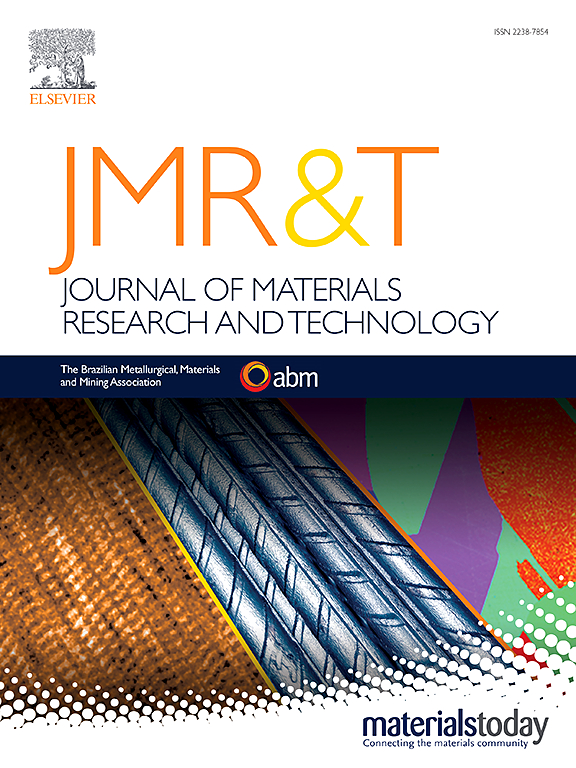采用改进的固有应变法和实验测量方法对激光粉末床熔合过程中产生的残余应力进行了详细的研究
IF 6.6
2区 材料科学
Q1 MATERIALS SCIENCE, MULTIDISCIPLINARY
Journal of Materials Research and Technology-Jmr&t
Pub Date : 2025-06-09
DOI:10.1016/j.jmrt.2025.06.062
引用次数: 0
摘要
在这项工作中,提出了一个多尺度有限元模型来模拟激光粉末床熔合(LPBF)过程,采用修正固有应变(MIS)方法。MIS是一种比传统的固有应变(is)技术更复杂的方法,最初是为焊接过程模拟而开发的。由于金属增材制造(AM)过程中存在复杂的热-机械相互作用,MIS方法已经发展到考虑这些相互作用,其中顺序沉积的层作为早期层的机械约束,影响整个过程中的应力和应变演变。多尺度建模方法可以有效地预测LPBF过程中产生的残余应力,这对评估制造零件的质量和性能至关重要。这项研究提供了一个新的贡献,通过系统地验证基于mis的残余应力预测,根据深度分辨x射线衍射(XRD)测量到地表以下3mm,解决了文献中的一个关键空白,即先前的工作主要集中在地表应力或变形上。对激光功率和扫描速度这两个关键工艺参数进行了修正,研究了它们对纵向和横向残余应力分布的影响。通过对制备的Inconel 625试样进行XRD测试,验证了模拟结果。虽然MIS方法与表层的实验数据吻合得很好,但在深层的次表层中出现了差异,由于简化了MIS假设,模拟往往低估了拉伸残余应力。改进的热-机械耦合和自适应热源模型可以提高LPBF过程中的应力预测精度。通过提供全面的深度解析分析,这项工作为地下应力演化提供了新的见解,这对于确保LPBF部件的结构完整性至关重要。该研究为MIS方法的能力提供了重要的评估,并为未来的研究机会提供了重要的指导,以改进lpbf生产零件的残余应力预测。本文章由计算机程序翻译,如有差异,请以英文原文为准。
A detailed investigation of induced residual stresses in the laser powder bed fusion process using the modified inherent strain approach and experimental measurements
In this work, a multiscale finite element model is proposed to simulate the Laser Powder Bed Fusion (LPBF) process, employing the Modified Inherent Strain (MIS) methodology. MIS is a more sophisticated approach than the conventional Inherent Strain (IS) technique, initially developed for welding process simulations. Due to the complex thermo-mechanical interactions present in the metal Additive Manufacturing (AM) process, the MIS approach has evolved to account for these interactions, in which sequentially deposited layers act as mechanical constraints on earlier layers, influencing stress and strain evolution throughout the process. A multiscale modeling approach can effectively predict the residual stresses induced during LPBF, which are essential for assessing the quality and performance of the manufactured part. This study provides a novel contribution by systematically validating MIS-based residual stress predictions against depth-resolved X-Ray Diffraction (XRD) measurements up to 3 mm below the surface, addressing a critical gap in the literature where prior works primarily focused on surface-level stress or distortion. Laser power and scanning speed, which are critical process parameters, were modified to investigate their individual impacts on the residual stress distribution in the longitudinal and transverse directions. Simulated results were validated through experimental XRD measurements on fabricated Inconel 625 test coupons. While the MIS method aligns well with the experimental data at the surface level, discrepancies arise in deeper subsurface layers, where simulations tend to underestimate tensile residual stresses due to simplified MIS assumptions. Refinement, such as improved thermo-mechanical coupling and adaptive heat source models, may enhance stress prediction accuracy in the LPBF process. By offering a comprehensive depth-resolved analysis, this work provides new insights into subsurface stress evolution, critical for ensuring the structural integrity of LPBF parts. The study provides a critical assessment of the MIS method's capabilities and offers essential guidance for future research opportunities to improve residual stress predictions in LPBF-produced parts.
求助全文
通过发布文献求助,成功后即可免费获取论文全文。
去求助
来源期刊

Journal of Materials Research and Technology-Jmr&t
Materials Science-Metals and Alloys
CiteScore
8.80
自引率
9.40%
发文量
1877
审稿时长
35 days
期刊介绍:
The Journal of Materials Research and Technology is a publication of ABM - Brazilian Metallurgical, Materials and Mining Association - and publishes four issues per year also with a free version online (www.jmrt.com.br). The journal provides an international medium for the publication of theoretical and experimental studies related to Metallurgy, Materials and Minerals research and technology. Appropriate submissions to the Journal of Materials Research and Technology should include scientific and/or engineering factors which affect processes and products in the Metallurgy, Materials and Mining areas.
 求助内容:
求助内容: 应助结果提醒方式:
应助结果提醒方式:


